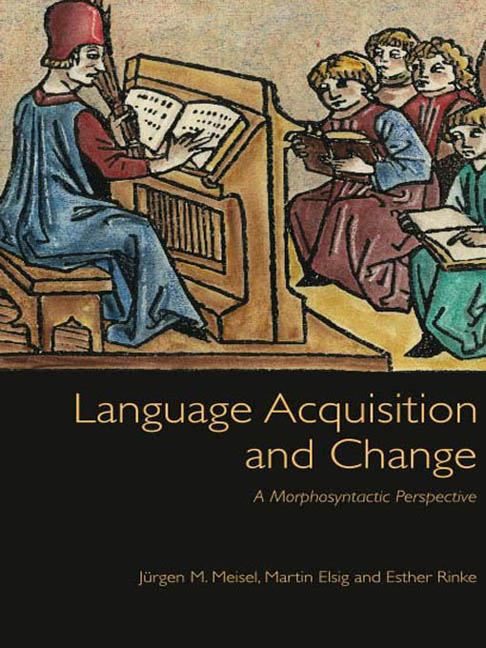Book contents
- Frontmatter
- Contents
- Preface
- Abbreviations
- 1 Variation and change in languages
- 2 Language change across the lifespan
- 3 The child as the locus and agent of grammatical change
- 4 Structural ambiguity as a possible trigger of syntactic change
- 5 Language contact as a possible trigger of change
- 6 Acquisition in multilingual settings: Implications for explanations of change
- 7 Towards an explanatory theory of grammatical change
- 8 References
- Index
5 - Language contact as a possible trigger of change
Published online by Cambridge University Press: 07 December 2017
- Frontmatter
- Contents
- Preface
- Abbreviations
- 1 Variation and change in languages
- 2 Language change across the lifespan
- 3 The child as the locus and agent of grammatical change
- 4 Structural ambiguity as a possible trigger of syntactic change
- 5 Language contact as a possible trigger of change
- 6 Acquisition in multilingual settings: Implications for explanations of change
- 7 Towards an explanatory theory of grammatical change
- 8 References
- Index
Summary
The discussion in the previous chapter has cast doubt on the plausibility of a scenario according to which structural ambiguity, in the sense of P-ambiguity, can be held responsible for grammatical restructuring in the process of L1 acquisition. In this chapter, we will examine whether language contact is a more likely candidate to induce grammatical change. Our focus is, again, on phenomena related to morphosyntax.
The chapter is introduced by Section 5.1, where we will discuss general assumptions concerning contact-induced diachronic change, focusing on the concepts of structural borrowing, convergence and shift-induced interference. Whereas many scholars assume a rather sceptical view with respect to cross-linguistic influence at the level of the grammatical system (Meillet 1921, 1938; Sapir 1927; Weinreich 1979), Thomason and Kaufman (1988: 14) state that ‘any linguistic feature can be transferred from any language to any other language’. They propose two main mechanisms, namely structural borrowing and shift-induced interference, which we will discuss in more detail. We will argue that direct structural borrowing is a problematic concept because in the relevant contexts where it has been proposed that this happens, alternative explanations are equally plausible. On the one hand, it has been proposed that structural similarity between contact languages may arise not only as a consequence of structural borrowing, but also due to universal processes of grammaticalization which operate on superficially similar or equivalent constructions (Heine and Kuteva 2003). On the other hand, as proposed by Silva-Corvalan (1998), language contact can lead to changes of an already existing form within a language, either with regard to its frequency of use or concerning its linguistic and pragmatic contexts of occurrence. In view of these alternative mechanisms which may lead to the same surface effects, it is far from being obvious how structural borrowing could possibly be identified and whether it is at all possible to do so (see also Poplack and Levey 2010). The second mechanism mentioned above, shift-induced interference, however, which consists in changes brought about by an imperfect learning of a language by a group of speakers with a different native language background (cf. also Thomason 2001), provides a more plausible scenario of contactinduced interference and has been discussed as a possible causal factor of language change in generative research (see e.g. Kroch and Taylor 1997; Weerman 1993; Meisel 2011b); we will return to this issue in the following chapter (Section 6.2).
- Type
- Chapter
- Information
- Language Acquisition and ChangeA Morphosyntactic Perspective, pp. 96 - 136Publisher: Edinburgh University PressPrint publication year: 2013



